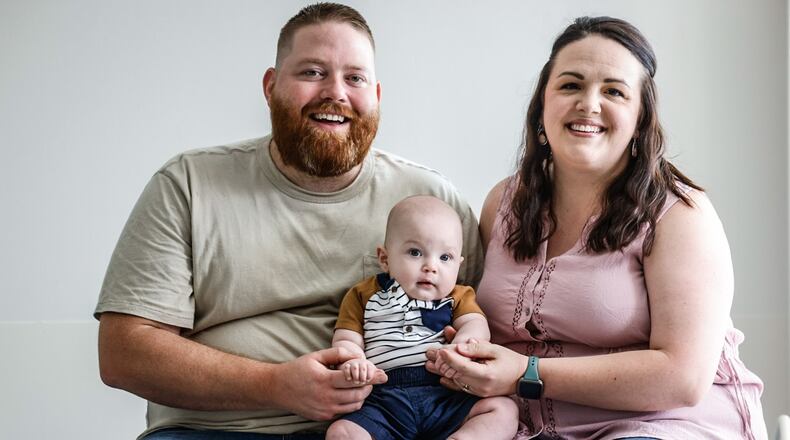Shriners had approximately 383 cleft lip and palate encounters with patients last year, including surgeries, clinic visits, and telehealth visits for patients with birth defects that occur when a baby’s lip and/or mouth do not form properly during pregnancy.
About one in every 1,600 babies born in the U.S. has a cleft lip with cleft palate, the Centers for Disease Control says, which is when the tissue that makes up the lip and the roof of the mouth do not join completely before birth. About one in every 2,800 babies born in the U.S. have a cleft lip without cleft palate, and about one in every 1,700 babies born have just a cleft palate with no cleft lip.
The causes of clefts among most infants are unknown, though the CDC speculates it could be a combination of genetic and/or environmental factors.
The issue came as a surprise to Amanda and Quentin Lauf of Springboro, when they found out their son Case was going to be born with a cleft lip when they went in for a 24-week anatomy scan during their pregnancy.
“It was scary when they told us,” Quentin said.
Doctors said Case would be born with a cleft lip, but they weren’t sure if he would also have a cleft palate until he was born.
“When he was born, we were pleasantly surprised that it was just the cleft lip and the palate was not affected,” Quentin said. “He was amazingly beautiful when he was born.”
Credit: Brooke Townsend www.brooketownse
Credit: Brooke Townsend www.brooketownse
Cleft lip and cleft palate were not birth defects found in either of their families, so Amanda and Quentin sought out different resources before connecting with Shriners and Case’s plastic surgeon, Dr. Salim Mancho. Children with these orofacial clefts can experience problems with feeding and speaking clearly, and they can also have hearing problems and problems with their teeth, according to the CDC.
“A lot of them have a hard time gaining weight. That was a big concern,” Amanda said.
Depending on the severity of the defect, some children may need a specialty bottle to eat, Quentin said.
Mancho conducted Case’s initial surgery correcting the cleft lip in May, a couple months after Case’s birth. Now five months old in July, his parents are getting used to his new smile.
“It’s such a big difference,” Amanda said.
Having their infant go through surgery was a difficult experience, they said, but one of the operating room nurses also had a child with a cleft lip when Case was getting his surgery, so the Laufs were able to get comfort from a parent who had been through the process.
“She had been in my shoes and knew how scary it was,” Amanda said. “I found a lot of people through social media, but I’ve never met any of them in person. ... It was nice to actually have met a cleft mom, especially in that moment.”
Credit: Jim Noelker
Credit: Jim Noelker
They also were able to get help from the care coordination team at Shriners, which includes registered nurses and dieticians familiar with the process, as well.
Mancho conducts a handful of surgeries each week on patients with craniofacial or other plastic surgery needs, and he said that every patient is different. Shriners treats children from across the U.S., along with international patients, Mancho said.
“It’s a special privilege to work on kids,” Mancho said.
Shriners, with its experience with scarring for burns, is also helping the Lauf family treat Case’s scar from his surgery to reduce its redness and visibility.
“The expertise is here to get you what you need and give your kid the aesthetic results that the parents want, because at the end of the day, what parents want is for their kids to be able to to go to school and not have a hundred and one questions,” Mancho said. “You want those kids to be able to be kids.”
About the Author




